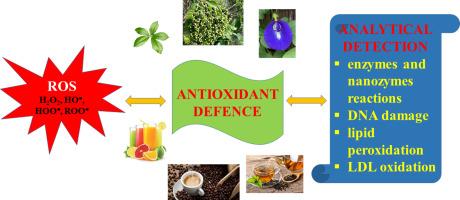Effective detection of antioxidants using functional schemes of enzyme inhibition and competing (bio)reactions
IF 3.7
Q1 CHEMISTRY, ANALYTICAL
引用次数: 0
Abstract
Numerous analytical methods were developed based on purely chemical, electrochemical and other physicochemical (spectral, chromatographic) interactions of the antioxidants (AOx) molecules with corresponding specific thermodynamic and kinetic background of experimental, mostly in vitro, conditions. Highly useful results are widely available which are however, operationally based and, therefore, not simply comparable. Reflecting the role of AOx in living organisms characterized by the biomolecular interactions, analytical procedures are also developed based on the antioxidant – pro-oxidant interactions in the presence of a biomolecule. In this case, enzymes fulfil the role of probe expressing an inhibition of their catalytic activity or nucleic acids, lipids, and others are the targets competing with AOx at a pro-oxidant attack. This review presents recent approaches and results on the analytical utilization of inhibiting and competing interactions with AOx. Novel trends exploiting nanomaterials and nanozymes are included. The studies of plant-derived extracts and products are particularly treated being of high pharmaceutical and medical interests. General features with future challenges regarding methods standardization development of portable devices and miniaturization technologies are highlighted to stimulate further progress in the effective AOx detection and characterization.

利用酶抑制和竞争(生物)反应的功能方案有效检测抗氧化剂
许多分析方法基于抗氧化剂(AOx)分子的纯化学、电化学和其他物理化学(光谱、色谱)相互作用,并具有相应的实验热力学和动力学背景,主要是在体外条件下。非常有用的结果可以广泛获得,但这些结果是基于操作的,因此不能简单地进行比较。为了反映AOx在生物体中以生物分子相互作用为特征的作用,也开发了基于生物分子存在下的抗氧化-促氧化相互作用的分析方法。在这种情况下,酶发挥探针的作用,表达对其催化活性的抑制,或者在促氧化攻击中与AOx竞争的目标是核酸、脂质和其他物质。这篇综述介绍了最近的方法和结果分析利用抑制和竞争相互作用与AOx。包括利用纳米材料和纳米酶的新趋势。植物源性提取物和产品的研究被特别处理,具有很高的制药和医学利益。强调了便携设备的标准化发展和小型化技术的一般特征和未来挑战,以促进有效的AOx检测和表征的进一步进展。
本文章由计算机程序翻译,如有差异,请以英文原文为准。
求助全文
约1分钟内获得全文
求助全文

 求助内容:
求助内容: 应助结果提醒方式:
应助结果提醒方式:


